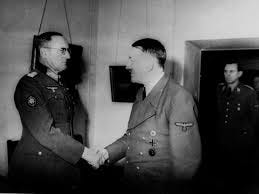Did Adolf Hitler successfully escape to Argentina? The possibility that Adolf Hitler escaped Germany and lived out his life in Argentina has been the subject of much speculation and conspiracy theories for decades. Despite the lack of concrete evidence, many people continue to believe that Hitler faked his own death and fled to South America to live out his remaining years in hiding. In this essay, we will explore the evidence both for and against this theory.
The official story is that Hitler committed suicide on April 30, 1945, in his bunker in Berlin as Allied forces closed in on the city. His body was reportedly burned and buried in a nearby location. However, there are many inconsistencies in the official story that have led some to question its validity.
One of the main arguments in favor of the theory that Hitler escaped to Argentina is the lack of a definitive body or forensic evidence to support the official story. The remains that were allegedly identified as Hitler’s were not subjected to DNA testing, and the dental records that were used to confirm his identity have been called into question. Some experts have suggested that the teeth belonged to someone other than Hitler, and that the dental records were faked.
There are also reports of eyewitnesses who claim to have seen Hitler and his girlfriend, Eva Braun, alive in Argentina after the war. In 1945, a German U-boat reportedly arrived in Argentina carrying high-ranking Nazi officials, including Martin Bormann, who was rumored to have helped Hitler escape. There are also reports of a German colony in Argentina that was established in the years following the war, and which was rumored to be a safe haven for former Nazis.
In addition to eyewitness accounts, there is some physical evidence that supports the theory that Hitler escaped to Argentina. In 2009, a skull fragment that was believed to belong to Hitler was subjected to DNA testing, and the results suggested that it did not match the DNA of the teeth that were used to confirm his identity. The fragment was reportedly found in the bunker where Hitler was believed to have died, but its origins are unclear.
On the other hand, there are many arguments against the theory that Hitler escaped to Argentina. For one thing, the logistics of such an escape would have been extremely difficult. Berlin was surrounded by Soviet forces in 1945, and it is difficult to imagine how Hitler could have escaped the city undetected. Even if he had managed to flee, it is unclear how he would have been able to reach South America without being caught.
Furthermore, there is no concrete evidence that Hitler ever expressed an interest in fleeing Germany or in living in Argentina. While it is true that many Nazis did flee to South America after the war, there is no evidence that Hitler himself was among them. In fact, the idea of escaping to South America was not even considered until several years after the war, when rumors began to circulate that Hitler might still be alive.
In addition, many of the eyewitness accounts of Hitler’s supposed escape have been called into question. Some of the witnesses were known to be unreliable, and their accounts were often based on hearsay and rumors. Furthermore, there is no physical evidence to support their claims.
One of the most convincing arguments against the theory that Hitler escaped to Argentina is the fact that there are no reliable records of his death. If Hitler had escaped, it is likely that he would have continued to play an active role in the Nazi movement, and there would be some record of his activities after 1945. However, there is no evidence that he was involved in any way in the post-war Nazi movement, and no reliable sightings of him have been reported since the end of the war.
In conclusion, while there are many arguments both for and against the theory that Hitler escaped to Argentina, the evidence overwhelmingly supports the official story that he died in his bunker in Berlin in 1945.
While there may be some inconsistencies in the official story, there is no concrete evidence to support the idea that Hitler escaped to South America. Eyewitness accounts are often unreliable, and physical evidence has not conclusively linked any remains to Hitler after his death. Furthermore, the logistics of such an escape would have been extremely difficult, and there is no evidence that Hitler expressed any interest in fleeing Germany or living in Argentina.
It is also important to consider the moral implications of perpetuating the theory that Hitler escaped to Argentina. By suggesting that he may have lived out his life in hiding, it undermines the horrors of the Holocaust and the atrocities committed by the Nazi regime. Hitler was responsible for the deaths of millions of people, and his actions cannot be justified or excused. By perpetuating this theory, we risk trivializing the suffering of those who were victimized by the Nazi regime.
In conclusion, while the theory that Hitler escaped to Argentina may be intriguing, there is no concrete evidence to support it. The official story of his death in his bunker in Berlin remains the most plausible explanation. It is important to remember the atrocities committed by the Nazi regime and to honor the memory of those who lost their lives during this dark period of history







